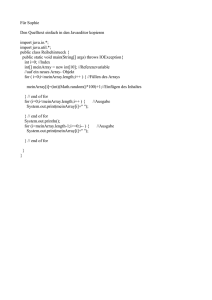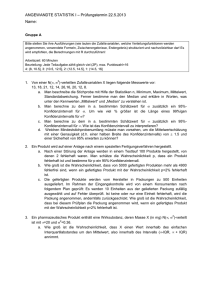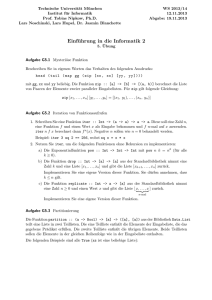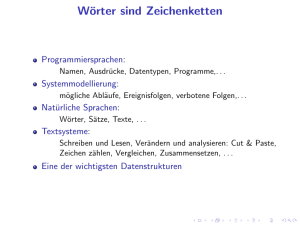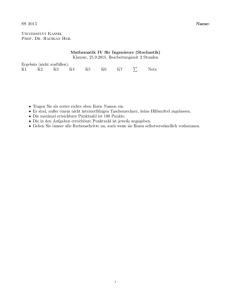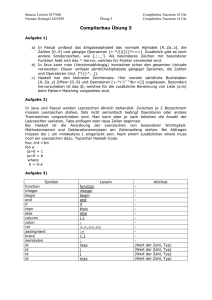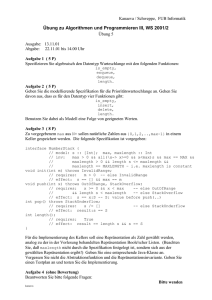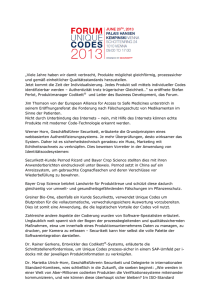musterlösung 4
Werbung
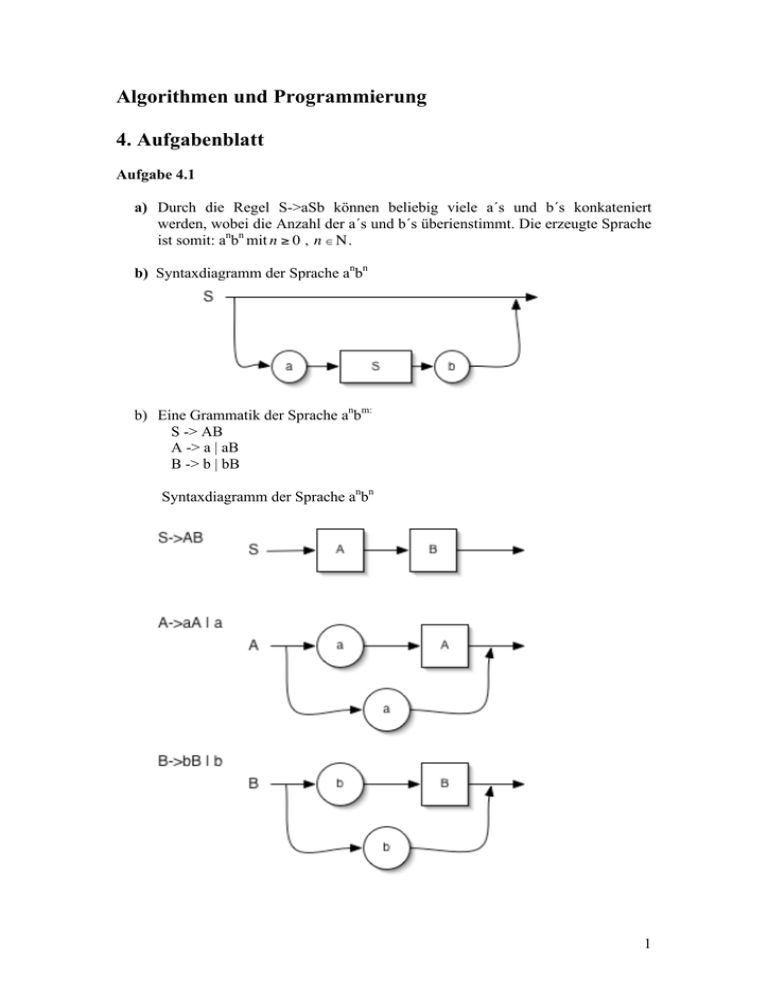
Algorithmen und Programmierung 4. Aufgabenblatt Aufgabe 4.1 a) Durch die Regel S->aSb können beliebig viele a´s und b´s konkateniert werden, wobei die Anzahl der a´s und b´s überienstimmt. Die erzeugte Sprache ist somit: anbn mit n " 0 , n # $ . b) Syntaxdiagramm der Sprache anbn ! b) Eine Grammatik der Sprache anbm: S -> AB A -> a | aB B -> b | bB Syntaxdiagramm der Sprache anbn 1 Aufgabe 4.2 Implementierung type Point = (Float, Float) type Line = (Point, Point) -- Gerade heißt akzeptabel, wenn x1<=x2 akzeptabel :: Line -> Bool akzeptabel ((x1,y1),(x2,y2)) = x1<=x2 -- Gerade ist senkrecht zur x-Achse, wenn -- x1==x2 und Gerade kein Punkt ist (y1/=y2) vertikal :: Line -> Bool vertikal ((x1,y1),(x2,y2)) = x1==x2 && y1/=y2 -- Die Gleichung (y-y1) / (x-x1) = (y2-y1) / (x2-x1) -- nach y umgestellt gibYzuX :: Float -> Line -> Float gibYzuX x ((x1,y1),(x2,y2)) | not (akzeptabel ((x1,y1),(x2,y2))) = error "keine Gerade" | (vertikal ((x1,y1),(x2,y2))) = error "Gerade vertikal" | otherwise = (y2-y1)*(x-x1)/(x2-x1)+y1 Testläufe *Programme> akzeptabel ((10,1),(1,1)) False *Programme> akzeptabel ((1,1),(10,1)) True *Programme> vertikal ((10,1),(10,2)) True *Programme> vertikal ((1,1),(10,2)) False *Programme> gibYzuX 2 ((1,1),(3,3)) 2.0 *Programme> gibYzuX 2 ((3,1),(3,3)) *** Exception: Gerade vertikal *Programme> gibYzuX 2 ((4,2),(3,3)) *** Exception: keine Gerade Aufgabe 4.3 Implementierung eines Volladdierers mit Hilfe von 2 Volladdierern data Bit = O | I deriving Show -- Boolsches OR bOR O O = O bOR O I = I 2 bOR I O = I bOR I I = I -- Boolsches AND bAND O O = O bAND O I = O bAND I O = O bAND I I = I -- Boolsches XOR bXOR O O = O bXOR O I = I bXOR I O = I bXOR I I = O -- Halbaddierer mit Ausgabe (Summe, Übertrag) bHalfAdder x y = (bXOR x y, bAND x y) -- Volladdierer mit Ausgabe (Summe, Übertrag) bVollAdder x y cin = (s2,cout) where (s,c) = bHalfAdder x y (s2,c2) = bHalfAdder s cin cout = bOR c2 c Testläufe *Programme> (I,O) *Programme> (O,I) *Programme> (I,O) *Programme> (I,I) bHalfAdder O I bHalfAdder I I bVollAdder O O I bVollAdder I I I Aufgabe 4.4 a) Haskell Code -- Anzahl der Elemente der Argumentenliste elemN :: [a] -> Int elemN [] = 0 elemN (x:xs) = 1 + elemN xs -- alle Duplikate entfernen mit Hilfe von -- elem aus der Prelude unique :: Eq a => [a] -> [a] unique [] = [] unique (x:xs) | x `elem` xs = unique xs | otherwise = x : unique xs -- Variante von unique unique2 [] = [] unique2 (x:xs) = x:(unique[y|y<-xs,y/=x]) 3 -- Anzahl verschiedener Elemente -- delem stützt sich auf unique ab delem xs = length (unique xs) Testläufe *Programme> elemN [1..10] 10 *Programme> unique ([1..10]++[1..10]) [1,2,3,4,5,6,7,8,9,10] *Programme> delem2 ([1..10]++[1..10]) 10 b) Insertion Sort in Haskell -- Füge i in die sortierte(!) Ergebnisliste ein insert :: Ord a => a -> [a] -> [a] insert i [] = [i] insert i (x:xs) | i <= x = i : (x : xs) | otherwise = x : (insert i xs) -- Entnimm ein Element der Argumentenliste und -- füge es in die Ergebnisliste ein insSort :: Ord a => [a] -> [a] insSort [] = [] insSort (x:xs) = insert x (insSort xs) Testläufe *Programme> iSort [10,9,8,7,6,5,4,3,2,1] [1,2,3,4,5,6,7,8,9,10] b) Auswertung von innen nach außen und von außen nach innen xs = [1,2, (3*4), 2] length [] = 0; length(x:xs) = 1 + length xs Auswertung: von außen nach innen Von innen nach außen: length [1,2,(3*4),2] = 1 + length [2,(3*4),2] = 1 + (1+length [(3*4),2] ) = 1 + ( 1 + ( 1 + length [2] ) ) = 1 + ( 1 + ( 1 +( 1+length []))) = 1 + ( 1 + ( 1 + ( 1+ 0 ) ) ) = 1 + ( 1 + ( 1 + 1 ) ) = 1 + ( 1 + 2 ) = 1 + 3 = 4 length [1,2,(3*4),2] = length [1,2,12,2] = 1 + length [2,12,2] = 1 + (1+length [(12,2] ) = 1 + ( 1 + ( 1 + length [2] ) ) = 1 + ( 1 + ( 1+( 1+length []))) = 1 + ( 1 + ( 1 + ( 1+ 0 ) ) ) = 1 + ( 1 + ( 1 + 1 ) ) = 1 + ( 1 + 2 ) = 1 + 3 = 4 Patrick Schäfer et al. 4
